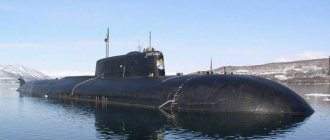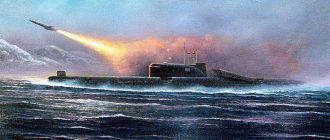Motorized rifle and tank units will soon receive a reliable “bodyguard” for protection against air attack, primarily when marching. The Gibka-S military air defense system is designed to guarantee the destruction of aircraft flying at low altitudes at speeds of up to 400 meters per second. The complex can also be successfully used in offensive and defensive operations. And not only to destroy enemy planes, helicopters and drones. Its 9M338 Igla-S and 9M336 Verba missiles can be used in modern combat to destroy enemy ground armored vehicles, manpower and engineering structures.
"Sea Soul" of an Infantry Recruit
...An attack drone emerging from low-hanging clouds sets fire to the first combat vehicle, and the second to the trailing one. A barrage of fire falls on a frozen column of armored vehicles. Enemy helicopters shoot at a unit that has lost mobility from a safe height and distance. Return fire with standard weapons of infantry fighting vehicles and armored personnel carriers is useless...
© mil.ru SAM "Gibka-S" on the march.
Such a scenario in modern warfare may become typical, standard for the destruction of military columns advancing to their destination. Try to attack motorized riflemen, tankers, and artillerymen from the air in places of deployment or in equipped strongholds: everywhere attacking aircraft will be met with fire by the forces and means of military air defense. “The weak link” is the marches. And, according to military theorists, there can be a lot of them in a modern highly maneuverable war. It is too wasteful and expensive to send the excellent Tor complex to accompany each battalion or individual company due to the high cost of its high-precision missiles. The Pantsir anti-aircraft missile and gun system (ZRPK) is now “taught” by designers to fire on the move, but it “works” better from equipped positions.
To solve the pressing problem of covering units and subunits of the Ground Forces, it was decided to “dry land” the successful “fly swatter” of the Navy. Developed by specialists from the Altair Naval Research Institute of Radio Electronics, part of the Almaz-Antey air defense concern, the 3M-47 air defense system has proven itself to be excellent in the navy. The Gibka guided weapon system is installed, for example, on the small artillery ships Astrakhan and Volgodonsk, and on the large anti-submarine ship Vice Admiral Kulakov.
© wikimedia.org
3M-47 "Gibka" air defense system on the large anti-submarine ship "Vice Admiral Kulakov".
Now it has been decided to use it as part of military air defense on the ground.
Reference
Air Defense Forces (Air Defense Forces) are a branch of the Ground Forces, designed to cover troops and objects from the actions of enemy air attacks when combined arms formations and formations conduct operations (combat operations), perform regroupings (march) and are positioned on the spot.
Today, air defense systems are capable of destroying enemy air attack weapons in the entire range of altitudes: extremely low - up to 200 m, low - from 200 to 1000 m, medium - from 1,000 to 4,000 m, high - from 4,000 to 12,000 m and in the stratosphere - more than 12,000 m.
The Russian air defense forces are armed with modern S-300V4, Buk-MZ, Tor-M2, Pantsir-S and others. In 2022, the share of modern equipment in military air defense should increase to 70 percent.
“It will close the entire planet”: Zhirinovsky boasted of the S-700 complex
The LDPR leader threatened the Americans with a no-fly zone over the entire Earth, which will be provided by the S-700 anti-aircraft missile system
Most likely, the leader of the LDPR, Vladimir Zhirinovsky, in a commendable, in principle, patriotic outburst, praised the Russian S-700 anti-aircraft missile system at the suggestion of... the Israeli Minister of Defense Avigdor Lieberman. This is what Tsargrad’s sources in the military sphere suggested, answering the question whether the ardent and enthusiastic Vladimir Volfovich had revealed a carefully guarded military secret.
No, in fact: elements of the S-500 Prometheus air defense system are still being tested. And at this time, to claim that Russia already has the S-700, being the deputy head of the State Duma (that is, a person informed by definition), means that now there should be a steady hum from rubbing palms over the entire town of Langley, Virginia, from where the CIA builds its sinister machinations. And over the Anacostia-Bolling base, where the US Defense Intelligence Agency is located, this sound should also be complemented by the clinking of glasses of champagne!
There is a cloudless sky over the entire planet
We all know and love Comrade Zhirinovsky. And just now, during Vladimir Solovyov’s broadcast, he once again received applause from the people.
And the Americans are afraid that the whole world will see that the best air defense system in the world is the Russian S-300. And we have S-400, S-500, S-600 and S-700. We can close the entire planet, and not a single plane will take off,
- announced the leader of the LDPR. In response to irresponsible attempts to sneer at the accuracy of this data and a call not to release even more relevant information regarding the S-1500 complex, the parliamentarian condescendingly rejected the pathetic insinuations:
The last one so far is the S-700. I think this will be the last air defense system, because there will be no more missiles to take off in the world. The S-700 will completely close everyone right at the launch sites, and this will be the last blow of the Russian air defense system.
V. Zhirinovsky. Photo: www.globallookpress.com
There is a no-fly zone over the entire planet. Just a geostrategist's dream! Avigdor Lieberman, Israel's Defense Minister, is probably locked in a bunker and shaking with fear...
Our response to Lieberman
However, evil tongues believe that Vladimir Zhirinovsky, in his passion, beloved by the masses, was precisely responding to Lieberman, perhaps even unconsciously. For the Israeli minister, also in a certain sense a friend (he is also a slave) of the fiery word, recently threw straight into the face of Mordor:
One thing needs to be clearly understood,” he said. “If anyone shoots at our planes, we will destroy them.” And it doesn’t matter whether it’s S-300 or S-700
(“One thing needs to be clear: if someone shoots at our planes, we will destroy them. It doesn’t matter if it’s an S-300 or an S-700”).
Since the entire Russian liberal clique immediately declared that “Lieberman can be trusted” and called for dusting one’s head with sand and quickly surrendering before Israel made a knight’s move, it is no wonder that this inspired Vladimir Zhirinovsky to give an adequate response to the Jewish minister.
“We don’t even have an S-500!”
But maybe Lieberman and Zhirinovsky really know something that no one else knows? They tell miracles about Israeli intelligence. And according to many publications - however, copied from each other - it was clear that Russia would supply to Syria not the S-300 complexes, but some kind of S-600 air defense systems. Moreover, in commercial quantities - almost 130 installations. This is despite the fact that Russia’s air defense missile defense system has only about 370 S-400 launchers and about 220 S-300 launchers.
In general, what miracles are told about this branch of the military! But Lieberman with his military intelligence AMAN and Zhirinovsky in their high post, it turns out, learned the truth?
In the military circles that Constantinople consulted, there were no people allowed into such secrets. And if they had, they would probably have turned their faces into bricks. But as professionals, these people quite soberly assess the state and potential of the Russian armed forces. And if we reduce their reaction to an aphoristic phrase expressed by one of them, then it will be expressed in the following words: “What kind of S-700, when in fact we don’t even have an S-500!”
And then, not just a few words without cases, but the opinion that Vladimir Volfovich’s insight was dictated by the best intentions, but that the respected vice-speaker of the State Duma does not have enough real information. And in general he argues with Avigdor Lieberman, and at the same time with the truth.
A. Lieberman. Photo: www.globallookpress.com
What is there?
But there are still S-300 air defense systems that are already forty years old, which in the Russian army are steadily being replaced by S-400 complexes. And the S-500, which really doesn’t exist yet, but it looks like it’s about to be, since specialists are already being trained for it.
What is S-500? This is a 5th generation air defense-missile defense system, on which a 40N6 missile is installed with a destruction altitude of 200-250 kilometers. That is, this is already an invisible wall being erected in space, because the orbits of the main military satellites are located at this altitude. Accordingly, ballistic missiles also lose their chances of flying safely towards Russia.
This missile is also notable for the fact that it has a fundamentally new homing head, which can switch to independently search for a target, after which it itself detects, overtakes and destroys it. And one can only imagine what will happen to this rocket when its “brain” acquires the functions of artificial intelligence, and this time is not far off...
At the same time, the missile reaches a speed of up to Mach 9, flies at a range of up to 500, or even 600 kilometers, hitting targets with a probability of up to 95%.
The Prometheus’s communications equipment generally belongs to the 6th generation, completely eliminating the possibility of radio interception and disablement due to external interference. But the complex itself is capable of completely suppressing target electronics using the latest electronic warfare equipment. It has even been tested in Syria.
The S-500 continues the general line of developers of air defense and missile defense systems towards the integration of air defense and missile defense systems already in service. In this sense, Prometheus will be integrated into a single network with the S-400 Triumph, S-300VM4 Antey-2500 and S-350 Vityaz systems. In addition, work is underway to unify this integrated air defense system with the A-135 Amur missile defense system of Moscow and the Moscow District.
But deliveries of the S-500 are promised to begin only in 2022. Previously, we were talking about 2016-2017.
S-400. Photo: www.globallookpress.com
What could have been?
In general, the public has long noted Vladimir Zhirinovsky’s modesty that distinguishes him from other politicians. He could have also named the S-800 system, but did not do so. Perhaps fearing premature deaths in the US and Israeli military establishment. After all, if you look at the line of how the S-300, S-400 and S-500 developed, then the S-600 model should already have properties that are fantastic today.
Let's take a step back. S-400:
The S-400 Triumph anti-aircraft missile system has been in service since 2007. Ensures the destruction of air (only their) targets at ranges up to 250 km (ballistic missiles - up to 60 km), at altitudes up to 27 km. Simultaneously fires at up to 36 targets flying at speeds of up to 4.8 thousand m/s.
The S-300 Favorit air defense system has been in service since 1978. Ensures the destruction of air targets at a range of up to 200 km, at altitudes of up to 27 km, flying at a speed of 2.8 km/s. Simultaneously fires at up to 36 targets.
In this case, the S-600 should be able to ensure a no-fly regime over all of Europe, and the S-700 - Vladimir Volfovich is right! - will be able to prohibit the adversary from flying over his own territory! Then the S-800 can take protection of nearby outer space, and the notorious S-1500, with which they so unsuccessfully tried to pin our politician, will hunt for asteroids and comets.
It's a pity that the Martians haven't been found yet...
From the ship to the ball
Created in cooperation with a number of research organizations and enterprises of the Russian military-industrial complex on the basis of a shipborne air defense system, the “infantry” version was called “Gibka-S”. JSC Research and Production Corporation Mechanical Engineering Design Bureau (Kolomna), FSUE GosNIIAS (Moscow), Research Institute of Applied Acoustics (Dubna), NPP Rubin (Penza), VNII Signal (Kovrov) took part in its development. , Saratov Aggregate Plant, State Ryazan Instrument Plant.
© mil.ru
The “infantry” version of the air defense system was called “Gibka-S”.
The maneuver “from ship to ball” after the testing of the Gibka-S anti-aircraft missile system at the Kapustin Yar training ground in the Astrakhan region was assessed in the official release of the Department of Information and Mass Communications of the Russian Ministry of Defense as follows: “Prototypes of the commander’s reconnaissance and control vehicle platoon and combat vehicle squad of anti-aircraft gunners with placement on the latter installation for MANPADS (man-portable anti-aircraft missile systems) during the tests confirmed the specified tactical and technical characteristics. A significant advantage of Gibka-S is the ability to remotely launch anti-aircraft guided missiles of all modifications of Verba and Igla MANPADS. In addition, the vehicle can fire at air targets in motion at speeds of up to 30 km/h. This makes it possible to effectively cover troops while marching.”
It also functions in a unified tactical level control system and provides reconnaissance, tracking and firing of air targets in motion and at a standstill. The combat vehicle of the MANPADS squad is equipped with a multi-channel optical-electronic detection and tracking system, high-speed guidance drives and remote missile launch devices.
© mil.ru
The Gibka-S anti-aircraft missile system includes a reconnaissance and control vehicle for the anti-aircraft platoon commander (MRUK) and combat vehicles of anti-aircraft gunner squads (BMO).
Device
The Granit rocket is made according to a normal aerodynamic design; it has a cigar shape, the annular air intake is located in the front part of the rocket.
The P-700 is equipped with folding, highly swept wings located in the central part of the fuselage, as well as a cross-shaped tail unit (it also folds out).
The missile is equipped with a KR-21-300 sustainer turbojet engine located in its rear part. Over most of its trajectory, the missile travels at 1.5 times the speed of sound (Mach 1.5), making it much more difficult to detect and destroy. At high altitudes, the P-700 can accelerate to 2.5 M. A ramjet engine was developed especially for Granit, which could accelerate the rocket to a speed of Mach 4.
It is especially worth highlighting the autonomous control system of this anti-ship missile system. The computer, which is the basis of the control system, has several information channels; it is capable of successfully resisting electronic warfare.
The P-700 Granit missile is located in a special launch container, which is filled with sea water before launch to equalize the pressure (this also happens on surface ships). Then, with the help of special solid propellant boosters, the P-700 reaches the surface of the water. In the air, the main engine begins to operate, the wings and tail stabilizers open.
"Granit" can be equipped with various types of warheads. This could be a high-explosive penetrating warhead weighing up to 750 kilograms. The missile can also be equipped with a nuclear warhead with a yield of up to 500 kilotons.
The guidance head is active, radar type.
P-700 “Granit” is a very “intelligent” missile. Immediately after launch, it rises to a high altitude and detects its target. After this, the missile descends to the lowest possible altitude and follows it until it hits the target. This flight mode greatly complicates the work of enemy missile defense.
Granit missiles can hunt their prey in a “flock”. The first P-700 locks onto a target (or targets) and points all other missiles at them. Each of them receives its own target, but if the guidance missile is destroyed, then another member of the “flock” takes over its functions. Missiles classify targets according to importance, choose the most optimal attack tactics and plan. The electronic control system of the missile contains data from all modern ships and methods for countering attacks. Missiles approaching a target constantly exchange information with each other.
All this allows the P-700 to decide what is in front of it: an AUG, a regular convoy or a landing group, and act accordingly. If a ship is destroyed by one missile, then the rest choose other targets.
Each missile is equipped with a radar jamming device and can emit decoys.
The rocket launches from a special container, which is installed at an angle of 47º.
Riding the Tiger
The deadly power of the Gibka-S air defense missile system is mounted on the powerful Tiger armored vehicle. The multi-purpose all-terrain vehicle produced by the Military-Industrial Company has been working in our troops for a long time, performing tasks as intended. And it is intended for reconnaissance, fire support, patrolling, escorting and guarding convoys. In combat conditions, the Tiger provides high protection for the crew, cargo and vehicle components from small arms and landmines.
The armored vehicle has been field tested in various natural and weather conditions. "Tiger" can operate in both heat and cold, it has high maneuverability in wooded and swampy areas, mountains and deserts. Even off-road, this armored vehicle is capable of reaching speeds of up to 90 km/h.
At such a highly mobile base, the Gibka-S anti-aircraft missile system will probably be useful to the Russian Airborne Forces, Marine Corps, and Army Special Forces.
More and more drums
New tasks and new capabilities of weapons and military equipment place increasingly high demands on the training of personnel of military air defense units. However, things are traditionally going well with this.
On the eve of the New Year, an extended meeting of the Military Council of the Army was held in Moscow under the leadership of the Commander-in-Chief of the Ground Forces, Army General Oleg Salyukov. During the meeting, the results of troop training in the 2022 academic year were summed up and tasks for the 2020 year were determined. In particular, the commander-in-chief noted that more than 290 applicants were involved in the verification of military formations for the assignment of the honorary name “shock” - from company to brigade inclusive. The main part of the units confirmed their intentions, the military personnel showed excellent results in carrying out all measures to bring them to the highest levels of combat readiness, a high level of moral and psychological state and coherence, solid knowledge, skills and abilities during control exercises.
© mil.ru
An extended meeting of the Military Council of the Army was held in Moscow under the leadership of the Commander-in-Chief of the Ground Forces, Army General Oleg Salyukov.
Army General Oleg Salyukov noted that more than 50 military formations have applied for the designation “shock” from military air defense. This is 70 percent more than in the 2022 school year.
Numbers
- 1,5 a trillion rubles were allocated in 2022 from the state budget of the Russian Federation for the implementation of the state defense order;
- 68 percent of these funds were allocated for serial complete purchases of high-tech weapons and equipment;
- 60 percent, the level of provision of permanent readiness units of the Ground Forces with modern weapons and equipment has reached;
- 436 The main types of missile and artillery weapons, including those for military air defense, are planned to be delivered to the Ground Forces, coastal forces of the Navy and Airborne Forces in 2022.
Anti-ship missile system P-700 "Granit"
In 1969, OKB-52 began developing the P-700 Granit long-range anti-ship weapon. In 1970, the preliminary design was completed. The complex is designed to strike formations of warships (primarily AUG), convoys and enemy landing forces with enhanced air defense and missile defense.
The Granit missile system, created by OKB-52 (now NPO Mashinostroeniya), had to meet extremely high requirements: maximum range - no less than 500 km, maximum speed - no less than 2500 km/h. Granit was distinguished from previous complexes of similar purposes by flexible adaptive trajectories, versatility in launch (underwater and surface), as well as carriers (submarines and surface ships), salvo firing with a rational spatial arrangement of missiles, and a noise-proof selective control system. It was allowed to fire at targets whose coordinates were known with large errors, as well as when the data became outdated for a long time. All operations for daily and launch maintenance of rockets have been automated. As a result, “Granit” acquired a real ability to solve any naval combat task with one carrier. However, the effectiveness of a long-range anti-ship missile system was largely determined by the capabilities of reconnaissance and target designation equipment. The “Success” system, which was based on the Tu-95 aircraft, no longer had the necessary combat stability. A new naval space reconnaissance and target designation system (MCRTS) - “Legend” - was created.
Testing of "Granit" began in November 1975 from a ground stand, and ended in August 1983, while since December 1980, launches were made from Project 949 submarines. By resolution of the Council of Ministers of March 12, 1983, the Granit complex was adopted for service.
The ZM-45 missile, equipped with both nuclear (500 kt) and high-explosive warheads weighing 750 kg, is equipped with a KR-93 sustainer turbojet engine with a ring solid-fuel rocket booster that begins operation under water. The maximum firing range is up to 600 km, the maximum speed corresponds to M=2.5 at high altitudes and M=1.5 at low altitudes. The launch mass of the rocket is 7000 kg, length is 9.15 m, body diameter is 0.85 m, wingspan is 2.6 m.
The missile embodies the rich experience of Soviet designers in creating electronic artificial intelligence systems, allowing them to act against a single ship according to the principle of “one missile - one ship” or “in a flock” against an order of ships. Missiles can be fired either singly or in one salvo (up to 24 anti-ship missiles, launched at a high tempo). The P-700 anti-ship missiles are completely autonomous after launch, have a complex flight path and a multi-variant program for attacking enemy formations. Thanks to the change in flight speed, anti-ship missiles of one salvo are able to form a dense group, which makes it easier to overcome enemy missile defense systems, and thanks to on-board control systems and mutual exchange of information, they can optimally distribute targets among themselves. Organizing the flight of all missiles in a salvo, additionally searching for a warrant and “covering” it with an activated radar sight allows the anti-ship missile to fly on the cruising sector in radio silence mode. During the flight of missiles, the optimal distribution of targets within the order is carried out between them (the algorithm for solving this problem was worked out by the Institute of Naval Armaments and NPO Granit). When approaching a detachment of enemy ships, the missiles themselves will distribute and classify according to the importance of the target, choose the attack tactics and plan for its implementation. To eliminate errors when choosing a maneuver and hitting a specific target, the on-board computer of the anti-ship missile system contains electronic data on modern classes of ships. In addition, the machine also contains purely tactical information, for example, about the type of orders of ships, which allows the missile to determine who is in front of it - a convoy, an aircraft carrier or a landing group, and attack the main targets in its composition. Also in the on-board computer there is data on countering enemy electronic warfare systems that can divert missiles from the target by jamming, and tactical techniques for evading air defense fire. As the designers say, after the launch of the missile, they themselves decide which of them will attack which target and what maneuvers need to be carried out for this in accordance with the mathematical algorithms embedded in the behavior program. The missile also has means to counter anti-missile missiles attacking it. Having destroyed the main target in the ship group, the remaining missiles attack other ships of the order, eliminating the possibility of two missiles hitting the same target.
On TARKR pr.1144 there are 20 Granit missiles in individual under-deck launchers SM-233. The TAVKR pr.1143.5 “Admiral Kuznetsov” is equipped with twelve missiles. In addition, 3 Project 949 nuclear submarines and 9 Project 949A submarines are armed with Granit missiles. Both types of boats have 24 launchers. The ship's control system can ensure the simultaneous preparation and launch of all 24 anti-ship missiles. Target designation can be obtained from the Legend MCRTs system, Tu-95RTs aircraft or Ka-25RTs helicopters.
Supersonic speed and a complex flight path, high noise immunity of radio-electronic equipment and the presence of a special system for removing enemy anti-aircraft and aircraft missiles provide the Granit, when firing in full salvo, with a high probability of overcoming the air defense and missile defense systems of an aircraft carrier formation. Currently, Project 949(A) submarines armed with the Granit complex, together with naval missile-carrying aircraft, are the basis of the anti-aircraft carrier forces of the Russian fleet. Thanks to the unique technical solutions laid down by the designers back in the 80s. last century, the Granit complex will retain its excellent combat qualities for a long time.
Assignment for tomorrow
Ten new types of weapons are being created for military air defense. This was announced in December 2019 in an interview with the newspaper of the Armed Forces of the Russian Federation “Red Star” by the head of the Air Defense Forces, Lieutenant General Alexander Leonov. He noted that in 2022 it is planned to complete state tests of the Adjutant target system, on the chassis of which targets are placed that simulate all modern air attack weapons, including cruise missiles, airplanes and helicopters.
Among the development work carried out by enterprises of the military-industrial complex on behalf of the Ministry of Defense is the development of a promising mobile anti-aircraft artillery system (ZAK) with a 57-mm high-ballistic automatic cannon “Derivation-PVO”. This complex is designed to combat mini- and micro-drones and should replace the Shilka anti-aircraft installation.
Fantasy in a different department
It is possible that Zhirinovsky’s decision to reveal the “military secret” is connected with the desire (conscious or unconscious) to gloss over the difficulties in developing a hypersonic missile.
And military expert Anton Lavrov believes that Zhirinovsky’s statement belongs to the category of fantasy, and unscientific at that.
At the level of modern - even promising - technologies, it is not possible to cover the entire planet with one anti-missile umbrella. “It didn’t work out even within the framework of the American Star Wars project,” he reminded Reedus.
To be able to destroy a launching rocket anywhere on the planet, several hundred platforms will have to be launched into low orbit. Russia does not and does not have the resources to implement such a grandiose program except in the imagination of the head of the LDPR.
(with voiceover)










